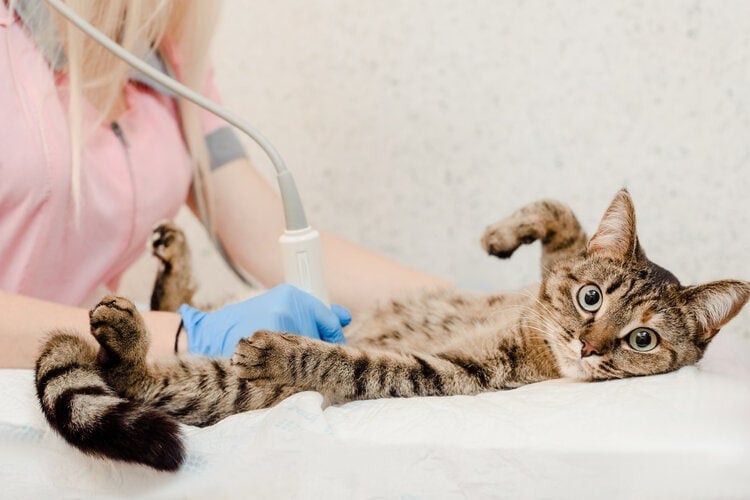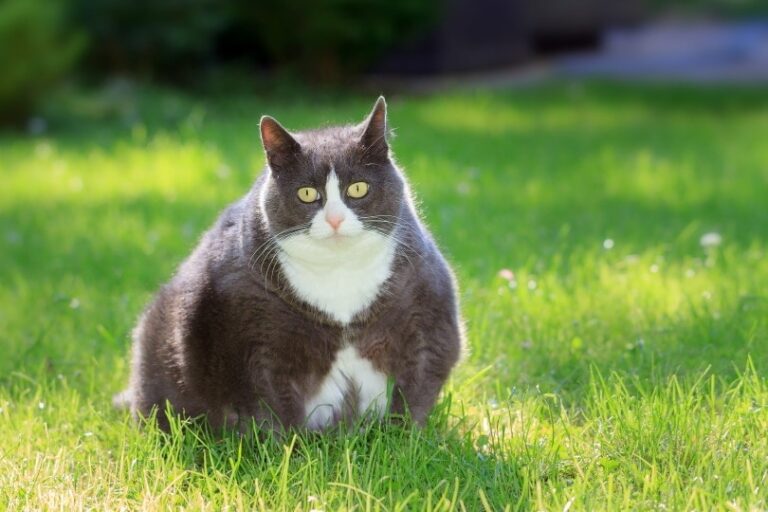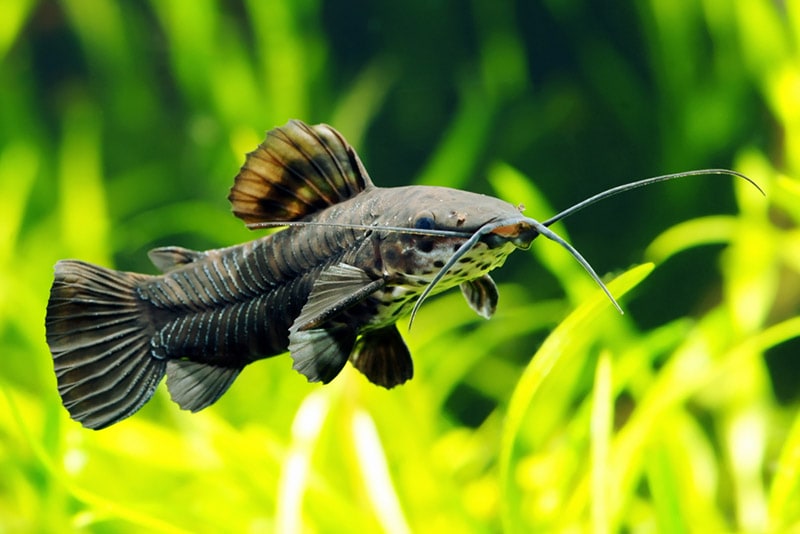VET APPROVED

The information is current and up-to-date in accordance with the latest veterinarian research.
Learn more »Click to Skip Ahead
Cats are adorable, independent creatures known for their curiosity and playful nature. Although many don’t welcome a tummy rub, they will often stretch out and show us their belly, and you may have spotted some small nipples poking out from beneath the fur, which may leave you wondering how many nipples cats have. Cats typically have 6 to 8 nipples, reaching from one end of the abdomen to the other. Why so many? And why do male cats have nipples too? Let’s learn more about a cat’s nipples and why they have so many.

Why Do Cats Have So Many Nipples?
How many nipples a mammal has is largely linked with how many offspring they are likely to have. Although sometimes a cat may have more kittens than nipples, the feline average litter size is around 4 to 6, so 6-8 nipples will usually be enough. A larger number of nipples means that a litter of kittens can feed simultaneously, which helps the mother cat ensure that each kitten is properly fed.
The exact number of nipples an individual cat will have is partially determined by their genetics, and partly dictated by development in the uterus.
What Happens if a Cat Has More Kittens Than Nipples?
This can happen, and it’s one of the times that we may really need to step up and help her out. If a cat has more kittens than nipples, it is important to provide proper nutrition and care for the mother cat and all of its kittens.Some mothers will cope by ensuring her kittens take turns at feeding, but if there is more than one or two extras, she is at risk of overextending herself, and the kittens may be at risk of malnutrition or starvation. Monitoring the weights of the kittens daily is important, making sure everyone is gaining weight and growing strong.
You will need to keep a close eye on each kitten’s nursing and consider supplementing feedings using a bottle or syringe and a cat milk replacer formula to ensure all kittens have healthy development and proper nutrition.

Pregnancy and Nipples
Female cats that haven’t been spayed will start to come into season (estrus) every 21-28 days from the age of around 5-6 months. The fluctuating estrogen levels will cause the nipples to become slightly larger than those of a juvenile, male, or spayed female cat, but they will still remain quite small until she becomes pregnant.
If a female cat becomes pregnant, her nipples will start to become more enlarged from around the second or third week of her pregnancy, and gradually the glandular tissue surrounding the tissue will become swollen as her milk ducts fill.
Cats typically nurse their young for about 8-12 weeks. During the first few days, the mother cat produces colostrum for her kittens which is packed full of vitamins and antibodies to help them fight off infections. After this, she will begin producing regular milk that provides all the necessary nutrition for the kittens to grow and thrive. During this time, the mother cat needs to be provided with plenty of food, water, and love so she can continue producing enough milk for her kittens. Once the kittens start to be weaned, at around 4-5 weeks, they should be given solid foods in order to receive the nutrition they need.
Nipple Problems
In the vast majority of cases, you will never have to think about your cat’s nipples, especially if they are male or are a female that was spayed before sexual maturity. Of course, like with any part of our pet’s anatomy, we should still be familiar with them so we know what is and isn’t normal for them. There are a few health issues or concerns that can affect feline nipples and mammary glands, so let’s take a look at the more common ones.
Cracked, bleeding, red nipples
This is obviously a problem, and it can affect cats of any sex or age. Inflamed or infected nipples may be caused by a number of things, including:
- Trauma – wounds or from scratching
- Dermatitis – skin infection or allergy
- Mastititis – inflammation or infection of the mammary tissue during or after nursing
- Cancer – some forms of skin or mammary cancer may initially resemble a sore or ulcer
- Hard or swollen nipples
It is normal for the nipples and mammary tissue of a pregnant cat to become enlarged over the course of the pregnancy. This enlargement is usually symmetrical, although different pairs of mammary glands may be larger or smaller than others.
A single nipple or gland should not be noticeably larger or harder than the others, and the nipples and glands of a non-pregnant or non-nursing cat should not be large, hard or swollen.
Lumps
Although mammary cancer is less common in cats than in dogs, the form of mammary cancer seen in cats is often more aggressive. Therefore, any lumps that you notice on the nipple or surrounding tissue should be treated with suspicion and examined by a vet urgently.
Discoloration
Some darkening of the nipples is quite normal during pregnancy, or in certain breeds and colors of cats. However, if you notice any unusual discoloration of the nipple, it is always best to seek veterinary advice, as other conditions, such as cancer, can also lead to discoloration of the skin.
‘New’ Nipples
Cats are born with the number of nipples they will have for life – they do not grow any more as they age. As cats get older, you may notice that tiny nipples become more obvious, but they will always have been there.
If you do notice any ‘new’ nipples, you should always get your vet to check them out. You may be seeing a tick, a skin tag, or a tumor, or you may just be noticing a supernumerary nipple. It’s always better to be safe than sorry.
Why Do Male Cats Have Nipples?
Just like male humans, male cats also have nipples, even though they typically do not produce milk or nurse kittens. This is because tissue differentiation occurs in an embryo before sex differentiation – the genes that control nipple development are active before the genes that determine if they will be male or female.
It’s important to remember that cats can have varying numbers of nipples, and supernumerary nipples are not a cause of concern.
However, if you do see something concerning about your cat’s nipples (like bleeding, cracking, or hanging down when not nursing), it’s always a good idea to speak with a veterinarian.

Cat Nipple FAQs

Q: Does spaying or neutering affect my cat’s nipples?
A: Generally speaking, the nipples of male cats will stay very small, whether they are entire or neutered. Female cats that have been spayed before they are sexually mature (5-6 months) or before they have had many estrus cycles will also tend to have very tiny nipples.
As they get older, the nipples of female cats are exposed to fluctuating estrogen levels, which will cause the nipples to become a little more prominent, and once they have had a litter, the nipples and surrounding tissue is usually much more pronounced, often with a circle of hairless skin surrounding the nipple itself.
Q: Do cats lose their nipples after they stop nursing their young?
A: No, once a cat stops nursing, the mammary tissue will gradually shrink down, but will always be more pronounced than before they had kittens. The number of nipples a cat has remains the same throughout their life, unless one is removed.

Q: Should I be concerned if my cat has stopped feeding its kittens from its nipples?
A: If your cat is not producing enough milk to feed its kittens, you should take it to the veterinarian for an evaluation. It may be due to a problem with the mammary gland, such as a blocked milk duct, or it may be due to inflammation or infection of the glandular tissue (mastitis). It could also be due to a problem with the kitten, so veterinary advice is essential.
Q: Is it normal for my cat’s nipples to be large and hanging?
A: It is normal for a nursing mother cat’s nipples to become enlarged and be more prominent than usual. This is because the extra strain of lactation causes them to swell, but they should return to their original size once the cat stops producing milk. Large, hanging nipples in a cat that isn’t nursing may indicate a hormonal problem, infection, or a tumor, so this definitely should be examined by a vet.

Q: Can kittens breastfeed from any cat or just their moms?
A: Kittens should only breastfeed from their own mother if possible. That being said, in cases where a mother kitten has died, becomes sick, or abandons her kittens, they can be fed by another lactating cat as long as the cat is healthy. In many cases, the new cat will adopt and raise the kitten. In fact, some nursing female cats have been known to feed orphans of different species, and vice versa!


Conclusion
The ability to have more than one offspring at a time is an important feature of species survival, but in order to raise multiple babies, cats also need to be able to feed them. On average, cats usually have between six and eight nipples, which is ideal for a species whose average litter size is four to six kittens.
Some cats may have extra nipples, known as supernumerary nipples, which may produce milk, but usually don’t. Just like with humans, male cats also have nipples, albeit very small ones. This is because the development of nipples occurs before sex is determined in the embryo.
For male cats and spayed females, the nipples are usually tiny, and will unlikely cause them – or you – any concern. Intact females or those who were spayed later in life will often have slightly or significantly more prominent nipples, and also have a higher risk of developing mammary cancer, so it’s important to keep an eye on those nipples, and spay and neuter your cats before they reach six months old.
Featured Image Credit: MR.RAWIN TANPIN, Shutterstock












